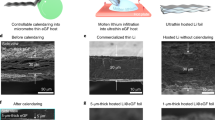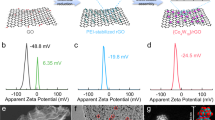Abstract
Metallic lithium is a promising anode candidate for future high-energy-density lithium batteries. It is a light-weight material, and has the highest theoretical capacity (3,860 mAh g–1) and the lowest electrochemical potential of all candidates. There are, however, at least three major hurdles before lithium metal anodes can become a viable technology: uneven and dendritic lithium deposition, unstable solid electrolyte interphase and almost infinite relative dimension change during cycling. Previous research has tackled the first two issues, but the last is still mostly unsolved. Here we report a composite lithium metal anode that exhibits low dimension variation (∼20%) during cycling and good mechanical flexibility. The anode is composed of 7 wt% ‘lithiophilic’ layered reduced graphene oxide with nanoscale gaps that can host metallic lithium. The anode retains up to ∼3,390 mAh g–1 of capacity, exhibits low overpotential (∼80 mV at 3 mA cm–2) and a flat voltage profile in a carbonate electrolyte. A full-cell battery with a LiCoO2 cathode shows good rate capability and flat voltage profiles.
This is a preview of subscription content, access via your institution
Access options
Subscribe to this journal
Receive 12 print issues and online access
$259.00 per year
only $21.58 per issue
Buy this article
- Purchase on Springer Link
- Instant access to full article PDF
Prices may be subject to local taxes which are calculated during checkout





Similar content being viewed by others
References
Tarascon, J. M. & Armand, M. Issues and challenges facing rechargeable lithium batteries. Nature 414, 359–367 (2001).
Armand, M. & Tarascon, J. M. Building better batteries. Nature 451, 652–657 (2008).
Chu, S. & Majumdar, A. Opportunities and challenges for a sustainable energy future. Nature 488, 294–303 (2012).
Bruce, P. G., Freunberger, S. A., Hardwick, L. J. & Tarascon, J. M. Li-O2 and Li-S batteries with high energy storage. Nature Mater. 11, 19–29 (2012).
Xu, W. et al. Lithium metal anodes for rechargeable batteries. Energy Environ. Sci. 7, 513–537 (2014).
Yamaki, J.-i. et al. A consideration of the morphology of electrochemically deposited lithium in an organic electrolyte. J. Power Sources 74, 219–227 (1998).
Aurbach, D., Zinigrad, E., Cohen, Y. & Teller, H. A short review of failure mechanisms of lithium metal and lithiated graphite anodes in liquid electrolyte solutions. Solid State Ionics 148, 405–416 (2002).
Bieker, G., Winter, M. & Bieker, P. Electrochemical in situ investigations of SEI and dendrite formation on the lithium metal anode. Phys. Chem. Chem. Phys. 17, 8670–8679 (2015).
Peled, E. The electrochemical behavior of alkali and alkaline earth metals in nonaqueous battery systems—the solid electrolyte interphase model. J. Electrochem. Soc. 126, 2047–2051 (1979).
Aurbach, D. et al. Attempts to improve the behavior of Li electrodes in rechargeable lithium batteries. J. Electrochem. Soc. 149, A1267–A1277 (2002).
Xu, K. Electrolytes and interphases in Li-ion batteries and beyond. Chem. Rev. 114, 11503–11618 (2014).
Bhattacharyya, R. et al. In situ NMR observation of the formation of metallic lithium microstructures in lithium batteries. Nature Mater. 9, 504–510 (2010).
Chandrashekar, S. et al. 7Li MRI of Li batteries reveals location of microstructural lithium. Nature Mater. 11, 311–315 (2012).
Harry, K. J., Hallinan, D. T., Parkinson, D. Y., MacDowell, A. A. & Balsara, N. P. Detection of subsurface structures underneath dendrites formed on cycled lithium metal electrodes. Nature Mater. 13, 69–73 (2014).
Lu, Y., Tu, Z. & Archer, L. A. Stable lithium electrodeposition in liquid and nanoporous solid electrolytes. Nature Mater. 13, 961–969 (2014).
Ota, H., Shima, K., Ue, M. & Yamaki, J.-i. Effect of vinylene carbonate as additive to electrolyte for lithium metal anode. Electrochim. Acta 49, 565–572 (2004).
Ota, H., Sakata, Y., Wang, X., Sasahara, J. & Yasukawa, E. Characterization of lithium electrode in lithium imides/ethylene carbonate and cyclic ether electrolytes: II. surface chemistry. J. Electrochem. Soc. 151, A437–A446 (2004).
Ding, F. et al. Dendrite-free lithium deposition via self-healing electrostatic shield mechanism. J. Am. Chem. Soc. 135, 4450–4456 (2013).
Qian, J. et al. High rate and stable cycling of lithium metal anode. Nature Commun. 6, 6362 (2015).
Crowther, O. & West, A. C. Effect of electrolyte composition on lithium dendrite growth. J. Electrochem. Soc. 155, A806–A811 (2008).
Li, W. et al. The synergetic effect of lithium polysulfide and lithium nitrate to prevent lithium dendrite growth. Nature Commun. 6, 7436 (2015).
Stone, G. M. et al. Resolution of the modulus versus adhesion dilemma in solid polymer electrolytes for rechargeable lithium metal batteries. J. Electrochem. Soc. 159, A222–A227 (2012).
Bouchet, R. et al. Single-ion BAB triblock copolymers as highly efficient electrolytes for lithium-metal batteries. Nature Mater. 12, 452–457 (2013).
Bates, J. B., Dudney, N. J., Neudecker, B., Ueda, A. & Evans, C. D. Thin-film lithium and lithium-ion batteries. Solid State Ionics 135, 33–45 (2000).
Kanno, R. & Murayama, M. Lithium ionic conductor thio-LISICON: the Li2SGeS2P2S5 system. J. Electrochem. Soc. 148, A742–A746 (2001).
Kamaya, N. et al. A lithium superionic conductor. Nature Mater. 10, 682–686 (2011).
Murugan, R., Thangadurai, V. & Weppner, W. Fast lithium ion conduction in garnet-type Li7La3Zr2O12 . Angew. Chem. Int. Ed. 46, 7778–7781 (2007).
Zheng, G. et al. Interconnected hollow carbon nanospheres for stable lithium metal anodes . Nature Nanotech. 9, 618–623 (2014).
Yan, K. et al. Ultrathin two-dimensional atomic crystals as stable interfacial layer for improvement of lithium metal anode. Nano Lett. 14, 6016–6022 (2014).
Iijima, S. & Ichihashi, T. Single-shell carbon nanotubes of 1-nm diameter. Nature 363, 603–605 (1993).
Yu, M.-F. et al. Strength and breaking mechanism of multiwalled carbon nanotubes under tensile load. Science 287, 637–640 (2000).
Novoselov, K. S. et al. Two-dimensional gas of massless Dirac fermions in graphene. Nature 438, 197–200 (2005).
Geim, A. K. & Novoselov, K. S. The rise of graphene. Nature Mater. 6, 183–191 (2007).
Ying, J. Y., Mehnert, C. P. & Wong, M. S. Synthesis and applications of supramolecular-templated mesoporous materials. Angew. Chem. Int. Ed. 38, 56–77 (1999).
Dahn, J. R., Zheng, T., Liu, Y. H. & Xue, J. S. Mechanisms for lithium insertion in carbonaceous materials. Science 270, 590–593 (1995).
Ng, S. H., Wang, J., Guo, Z. P., Wang, G. X. & Liu, H. K. Single wall carbon nanotube paper as anode for lithium-ion battery. Electrochim. Acta 51, 23–28 (2005).
Lee, S. W. et al. High-power lithium batteries from functionalized carbon-nanotube electrodes. Nature Nanotech. 5, 531–537 (2010).
Hu, L. B. et al. Silicon-carbon nanotube coaxial sponge as Li-ion anodes with high areal capacity. Adv. Energy Mater. 1, 523–527 (2011).
Wang, H. L. et al. Graphene-wrapped sulfur particles as a rechargeable lithium-sulfur battery cathode material with high capacity and cycling stability. Nano Lett. 11, 2644–2647 (2011).
Liu, J. Charging graphene for energy. Nature Nanotech. 9, 739–741 (2014).
Raccichini, R., Varzi, A., Passerini, S. & Scrosati, B. The role of graphene for electrochemical energy storage. Nature Mater. 14, 271–279 (2015).
Son, I. H. et al. Silicon carbide-free graphene growth on silicon for lithium-ion battery with high volumetric energy density. Nature Commun. 6, 7393 (2015).
Zhou, G., Paek, E., Hwang, G. S. & Manthiram, A. Long-life Li/polysulphide batteries with high sulphur loading enabled by lightweight three-dimensional nitrogen/sulphur-codoped graphene sponge. Nature Commun. 6, 7760 (2015).
Reddy, A. L. M. et al. Synthesis of nitrogen-doped graphene films for lithium battery application. Acs Nano 4, 6337–6342 (2010).
Dikin, D. A. et al. Preparation and characterization of graphene oxide paper. Nature 448, 457–460 (2007).
Sun, G. et al. Actuation triggered exfoliation of graphene oxide at low temperature for electrochemical capacitor applications. Carbon 68, 748–754 (2014).
Gao, Y. et al. Popping of graphite oxide: application in preparing metal nanoparticle catalysts. Adv. Mater. 27, 4688–4694 (2015).
Marcano, D. C. et al. Improved synthesis of graphene oxide. ACS Nano 4, 4806–4814 (2010).
Ganguly, A., Sharma, S., Papakonstantinou, P. & Hamilton, J. Probing the thermal deoxygenation of graphene oxide using high-resolution in situ X-ray-based spectroscopies. J. Phys. Chem. C 115, 17009–17019 (2011).
Aurbach, D. Nonaqueous Electrochemistry (CRC, 1999).
Acknowledgements
Y.C. acknowledges the support from the Assistant Secretary for Energy Efficiency and Renewable Energy, Office of Vehicle Technologies of the US Department of Energy under the Battery Materials Research (BMR) program.
Author information
Authors and Affiliations
Contributions
D.L., Y.L. and Y.C. conceived the idea and experiments. D.L. and Y.L. carried out the synthesis and performed the materials characterizations and electrochemical measurements. Z.L. assisted the electrochemical measurements. H.W.L. conducted in situ TEM characterization. J.S. performed the first-principles calculations. H.W. and K.Y. assisted in the Raman and XPS measurement. J.X. assisted the XPS analysis. D.L., Y.L. and Y.C. co-wrote the paper. All authors discussed the results and commented on the manuscript.
Corresponding author
Ethics declarations
Competing interests
The authors declare no competing financial interests.
Supplementary information
Supplementary information
Supplementary information (PDF 2431 kb)
Supplementary information
Supplementary Movie 1 (MOV 5338 kb)
Supplementary information
Supplementary Movie 2 (MOV 13251 kb)
Supplementary information
Supplementary Movie 3 (MOV 10222 kb)
Supplementary information
Supplementary Movie 4 (MOV 8542 kb)
Supplementary information
Supplementary Movie 5 (MOV 10231 kb)
Supplementary information
Supplementary Movie 6 (MOV 9557 kb)
Rights and permissions
About this article
Cite this article
Lin, D., Liu, Y., Liang, Z. et al. Layered reduced graphene oxide with nanoscale interlayer gaps as a stable host for lithium metal anodes. Nature Nanotech 11, 626–632 (2016). https://doi.org/10.1038/nnano.2016.32
Received:
Accepted:
Published:
Issue Date:
DOI: https://doi.org/10.1038/nnano.2016.32
This article is cited by
-
Transition metals for stabilizing lithium metal anode: advances and perspectives
Tungsten (2024)
-
Lithium-induced graphene layer containing Li3P alloy phase to achieve ultra-stable electrode interface for lithium metal anode
Rare Metals (2024)
-
A high-performance lithium anode based on N-doped composite graphene
Rare Metals (2024)
-
Two-dimensional materials for high density, safe and robust metal anodes batteries
Nano Convergence (2023)
-
High-entropy electrolytes for practical lithium metal batteries
Nature Energy (2023)



